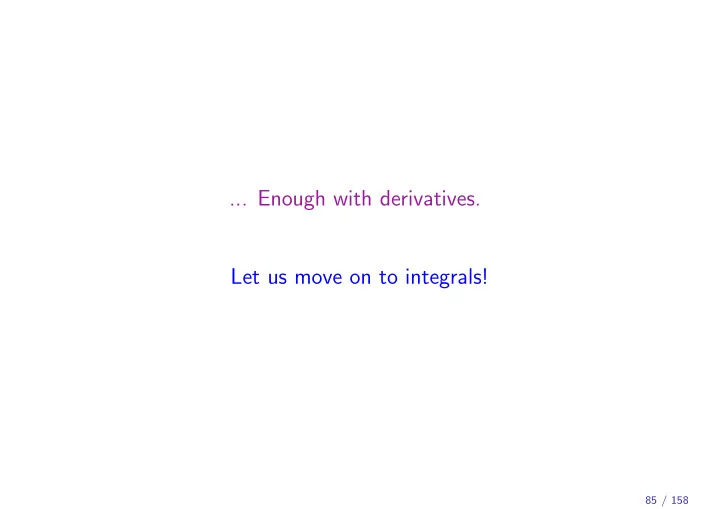

... Enough with derivatives. Let us move on to integrals! 85 / 158
Integrals Recall the notion of integration in one variable... � b n � f ( x ) d x = lim f ( x i )( x i − x i − 1 ) n →∞ a i =1 We call this the Riemann integral of f . 86 / 158
Integrals Why do we like integrals? ◮ They give us the (signed) area/volume under/over a function. Applications: calculation of areas, arc-lengths, volumes, surface areas etc. ◮ Integration is ”inverse” operation of differentiation. Applications: calculation of antiderivatives (indefinite integrals) 87 / 158
Fundamental Theorem of Calculus Theorem: If there exists differentiable function F such that F ′ = f , for an (integrable) function f , then � b f ( x ) d x = F ( b ) − F ( a ) . a Second form of the FTC: � x d f ( t ) d t = f ( x ) . d x a BIG IDEA: Differentiation and integration are ”inverse” operations! 88 / 158
Integrals Let f , g (integrable) functions. Then � � � f + g d x = f d x + g d x ◮ � � h ( y ) f ( x ) d x = h ( y ) f ( x ) d x for h (integrable) function. ◮ � � f ( x ) g ′ ( x ) d x = f ( x ) g ( x ) − f ′ ( x ) g ( x ) d x ◮ or � b � b f ( x ) g ′ ( x ) d x = [ f ( x ) g ( x )] b f ′ ( x ) g ( x ) d x a − a a Integration by parts! ... maybe the most important formula in applied analysis. 89 / 158
Double Integrals Let f : R 2 → R function. We define the double integral of f by m n �� � � f ( x , y ) d x d y = lim m →∞ lim f ( x i , y j )( x i − x i − 1 )( y j − y j − 1 ) n →∞ Ω i =1 j =1 90 / 158
Double Integrals over Rectangles Let f : [ a , b ] × [ c , d ] ⊂ R 2 → R (integrable) function. The double integral of f is then � d �� b � b �� d � � �� f ( x , y ) d x d y = f ( x , y ) d x d y = f ( x , y ) d y d x Ω c a a c BIG IDEA: The double integral of a con- tinuous function over a rectangular do- main is equal to the iterated integrals. Remark: We can use either of the two forms (red or blue) depending on which one is more convenient in each particular case. 91 / 158
Double Integrals over Rectangles Example 1: Let f ( x , y ) = cos x sin y . Compute the double integral of f over the rectangle Ω = [0 , π 2 ] × [0 , π 2 ]. Solution: We have �� � π π � 2 2 cos x sin y d x d y = · · · = 1 . 0 0 Similarly �� � π π � 2 2 cos x sin y d y d x = · · · = 1 . 0 0 92 / 158
Double Integrals over Rectangles Example 2: Let f ( x , y ) = x sin y . Find the double integral of f over the rectangle Ω = [0 , 1] × [0 , π ]. Solution: We have �� 1 � π � �� x sin y d x d y = x sin y d x d y = · · · = 1 . Ω 0 0 Similarly � 1 �� π � �� x sin y d x d y = x sin y d y d x = · · · = 1 . Ω 0 0 93 / 158
Double Integrals over Simple Domains Problem: Let f : D ⊂ R 2 → R . What is the double integral of f over D , when D is of the following form? Solution: � b �� φ 2 ( x ) � �� f ( x , y ) d x d y = f ( x , y ) d y d x φ 1 ( x ) D a Domains of the form D = { ( x , y ) ∈ R 2 : a ≤ x ≤ b , φ 1 ( x ) ≤ y ≤ φ 2 ( x ) } are called x -simple domains. 94 / 158
Double Integrals over Simple Domains Example: Let f ( x , y ) = xy . Compute the double integral of f over the domain bounded by y = √ x , the x -axis, x = 1, and x = 3. 2 1.8 Solution: D is x -simple. Indeed, 1.6 x=1 y=\/x D = { ( x , y ) : 1 ≤ x ≤ 3 , 0 ≤ y ≤ √ x } . 1.4 x=3 1.2 1 D We have 0.8 � √ x � 3 0.6 xy d y d x = · · · = 13 3 . 0.4 1 0 0.2 y=0 0 0 0.5 1 1.5 2 2.5 3 3.5 4 95 / 158
Recommend
More recommend